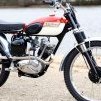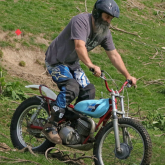-
Posts
431 -
Joined
-
Last visited
-
Glen, just another thriving ITSA group....... hope to see you soon! I'm down in the lower portion of the state in Dolores. Tony
-
We really need a picture of the rear wheel from both sides. Just from logic it looks like the spacers are in the wrong side as the long one should be on the brake side. Tony
-
Lots of good pointers here and all valid. Check the condition of the wire from the points which can often become hard and brittle and will need replacing if this is the case. Sometimes you can purchase new OEM points which come with a sort of "Teflon" coating which NEEDS to be file off! Tony
-
What size main jet are you running ?
-
Assuming nobody has altered the standard of 13/53 all you need to do is change the front sprocket to 12T, a very simple operation. Do not be tempted to go to 11T ! Tony
-
If you are working with a VM26 an ideal starting point is 155 main and 35-40 pilot from sea level to around 4000' then come down 5-10 on both. Tony
-
On the TY250A frame the fixing bracket on the rear frame loop is slightly offset! If you drill the center of the new mudguard you will see that it is NOT centered over the tyre/tire. Tony
-
This is my DMW which had the fuel in the top tube, square section swinging arm and Hagon gas shocks, and the original seat. Up front I fitted an Ossa MAR front end and a TY250A engine and rear wheel. Tony
-
As you can see from your own picture the cable won't fit with it's holder fitted to the brake arm, and likewise can't fall out of there when fitted correctly. Pull the split pin and fit the extended nipple in the hole (you may need to cut a little of the black plastic cable cover off) It makes NO difference which way round you fit the holder. With regard to "poor brakes" while a NEW cable will give you a smoother action I would replace the OEM shoes with the EBC grooved ones and also before fitting remove the actuating rod attached to the brake arm. Give it a really good cleaning and a light greasing when refitting as this will stop the brake locking on. Tony
-
.......and on MY bike too!!! Tony
-
Depends where you live, what competitions you plan on riding, their rules, and of course what you are willing to pay. In the USA for example I can use BSA B50 four stud forks and their yokes which are 3/4" and fit perfectly. If you use Yam TY250 forks and their yokes you will need to get either bearing holders or the stem machined to the Cub. Yam forks and yokes work well but do extend the wheelbase by 1/2". There are of course many other options but I fear they are not cheap! Tony
-
A very interesting discussion with plenty of input from experienced riders. Taking a slice of history into the equation and going back into the 60's even the purpose built machines of the era all had solid welded footrests and fairly flat bars with hardly any lift. Just look at an unmodified Greeves from those days, a classic being the 24TES. Our standard posture was the "banana bend" stance. In those days it was not uncommon for footrests to get broken off and we then progressed to small painful spring loaded units mounted higher on the frame and many top riders having their own handlebars made by Renthal with around a 7" lift. Riding styles of the period were either Sammy Miller and Gordon Farley, knees together, or gripping the tank, and balance controlled by upper body movement or in contrast to our British Experts from the Southern Centers the rock experts from Yorkshire were using the "knees wide apart" lavatory stance allowing the bike to bounce left and right without needing the out of balance dab. Throughout the 70's we were set on this design with high footrests (around 14" and 7.5" lift bars). Higher the footrests=higher the bars to maintain our "banana bend". Wheelbase on the majority of machines was 52.5". Handlebars were set to a neutral position with the bend of the lift being in line with the fork action. Rotate the bars forward and the Cowhorn portion of the bars will cause your wrists to cant inwards and you will increase the pressure of your grip, take it too far forward and you will have too much weight over the front wheel with all the problems that will cause. Rotate the bars rearward and you will soften the banana and be standing too upright and find the bike difficult to manage on long steep climbs. Moving the footrests back and down is a great idea, 2 x 2, seems about right as it lowers the center of gravity, but one of the critical measurements seems to be the distance from front wheel spindle to center of rest which from my experience over 50 years is between 38-39" One day we will get it right! TONY
-
Your main problem would seem to be the chain and sprocket set up and nothing to do with the clutch. The original set up was 13 front and 53 rear with a 428 chain. The ideal for modern day events is 12 front and 53 rear. Any smaller on the front and it will bite into the swinging arm and clack as it tries to follow the front causing the chain tensioner to bounce. Tony
-
The BEST cables made for the Yam are the OEM ones as other makes do not usually have all the "extras". Your best bet is to go to Speed & Sport PA web site (Yamatopdog) and if you are buying new clutch and brake cables they come with the lever covers as well. Tony







